Öz
In
this study, using dynamic model of passive and active morphing featured
Tactical Unmanned Aerial Vehicle (TUAV) called as ZANKA III which is produced
in Erciyes University, Faculty of Aeronautics and Astronautics, Model Aircraft
Laboratory, under the TUBITAK ARDEB 1001 program and designing Output
Constrained Variance Controller for aircraft tracking the desired trajectory
achieved with minimal vibration and minimum energy consumption. For this
purpose, using MATLAB, in the simulation environment, studies have been
performed and closed loop responses have been obtained. Longitudinal motion is
in primary interest, desired output is pitching angle of TUAV, and desired
input is elevator angle.
Anahtar Kelimeler
Kaynakça
- R. Austin, Unmanned aircraft systems. Wiley, 2010.
- M. F. Bento, Unmanned aerial vehicles: An Overview. Working papers, 2008.
- Nelson, R. C. 2007. Flight Stability and Automatic Control. 2nd ed., McGraw-Hill, New York, chapters 2-6.
- Hsieh C., Skelton R. E. and Damra F. M., 1989, Minimum energy controllers with inequality constraints on output variances, Optimal Control Application and Methods, 10 (4), 347-366.
- Zhu G. and Skelton R E., 1991, Mixed and problems by weight selection in quadratic optimal control. International Journal of Quadratic Optimal Control, 63 (5) : 1161-1176.
Öz
In this study, using dynamic model of passive and active morphing featured Tactical Unmanned Aerial Vehicle (TUAV) called which is produced in Erciyes University, Faculty of Aeronautics and Astronautics, Model Aircraft Laboratory, under the TUBITAK ARDEB 1001 program and designing Output Constrained Variance Controller for aircraft tracking the desired trajectory achieved with minimal vibration and minimum energy consumption. For this purpose, using MATLAB, in the simulation environment, studies have been performed and closed loop responses have been obtained. Longitudinal motion is in primary interest, desired output is pitching angle of TUAV, and desired input is elevator angle.
Anahtar Kelimeler
Kaynakça
- R. Austin, Unmanned aircraft systems. Wiley, 2010.
- M. F. Bento, Unmanned aerial vehicles: An Overview. Working papers, 2008.
- Nelson, R. C. 2007. Flight Stability and Automatic Control. 2nd ed., McGraw-Hill, New York, chapters 2-6.
- Hsieh C., Skelton R. E. and Damra F. M., 1989, Minimum energy controllers with inequality constraints on output variances, Optimal Control Application and Methods, 10 (4), 347-366.
- Zhu G. and Skelton R E., 1991, Mixed and problems by weight selection in quadratic optimal control. International Journal of Quadratic Optimal Control, 63 (5) : 1161-1176.
Ayrıntılar
| Birincil Dil | İngilizce |
|---|---|
| Konular | Mühendislik |
| Bölüm | Makaleler |
| Yazarlar | |
| Yayımlanma Tarihi | 31 Aralık 2018 |
| Yayımlandığı Sayı | Yıl 2018 Sayı: 14 |


